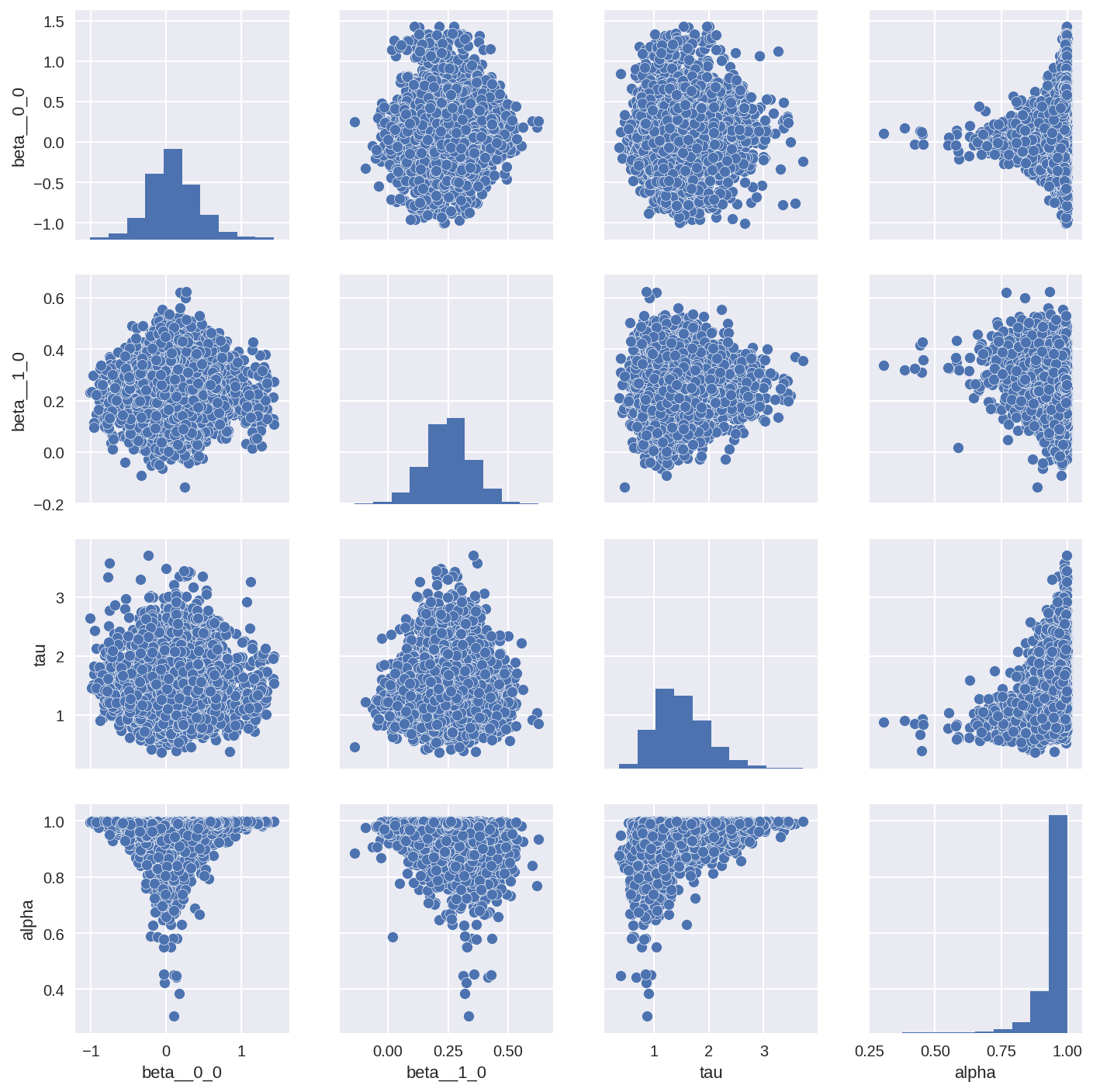In [1]:
%pylab inline
import numpy as np
import scipy.stats as stats
import pymc3 as pm
from theano import shared
import theano
import theano.tensor as tt
floatX = "float32"
%config InlineBackend.figure_format = 'retina'
plt.style.use('ggplot')
Populating the interactive namespace from numpy and matplotlib
PyMC3 Modeling tips and heuristic¶
A walkthrough of implementing a Conditional Autoregressive (CAR) model
in PyMC3, with WinBugs/PyMC2 and STAN code as
references.
- Notebook Written by Junpeng
Lao, inspired by
PyMC3issue#2022, issue#2066 and comments. I would like to thank [@denadai2](https://github.com/denadai2), [@aseyboldt](https://github.com/aseyboldt), and [@twiecki](https://github.com/twiecki) for the helpful discussion.
As a probabilistic language, there are some fundamental differences
between PyMC3 and other alternatives such as WinBugs, JAGS,
and STAN. In this notebook, I will summarise some heuristics and
intuition I got over the past two years using PyMC3. I will outline
some thinking process of how I approach a modelling problem using
PyMC3, and how thinking in linear algebra solves most of the
programming problem. I hope this notebook will shed some light into the
design and feature of PyMC3, and similar language built on linear
algebra package with a static world view (e.g., Edward, which is based
on Tensorflow).
For more resources comparing between PyMC3 codes and other probabilistic languages: * PyMC3 port of “Doing Bayesian Data Analysis” - PyMC3 vs WinBugs/JAGS/STAN * PyMC3 port of “Bayesian Cognitive Modeling” - PyMC3 vs WinBugs/JAGS/STAN * [WIP] PyMC3 port of “Statistical Rethinking” - PyMC3 vs STAN
Background information¶
where \(\sigma_i^{2}\) is a spatially varying covariance parameter, and \(b_{ii} = 0\).
Here we will demonstrate the implementation of a CAR model using the
canonical example: the lip cancer risk data in Scotland between 1975 and
1980. The original data is from (Kemp et al. 1985). This data set
includes observed lip cancer case counts at 56 spatial units in
Scotland, with the expected number of cases as intercept, and an
area-specific continuous variable coded for the proportion of the
population employed in agriculture, fishing, or forestry (AFF). We want
to model how lip cancer rates (O below) relate to AFF (aff
below), as exposure to sunlight is a risk factor.
Setting up the data:
In [2]:
county = np.array(["skye_lochalsh", "banff_buchan", "caithness,berwickshire", "ross_cromarty",
"orkney", "moray", "shetland", "lochaber", "gordon", "western_isles",
"sutherland", "nairn", "wigtown", "NE.fife", "kincardine", "badenoch",
"ettrick", "inverness", "roxburgh", "angus", "aberdeen", "argyll_bute",
"clydesdale", "kirkcaldy", "dunfermline", "nithsdale", "east_lothian",
"perth_kinross", "west_lothian", "cumnock_doon", "stewartry", "midlothian",
"stirling", "kyle_carrick", "inverclyde", "cunninghame", "monklands",
"dumbarton", "clydebank", "renfrew", "falkirk", "clackmannan", "motherwell",
"edinburgh", "kilmarnock", "east_kilbride", "hamilton", "glasgow", "dundee",
"cumbernauld", "bearsden", "eastwood", "strathkelvin", "tweeddale",
"annandale"])
# observed
O = np.array([9, 39, 11, 9, 15, 8, 26, 7, 6, 20, 13, 5, 3, 8, 17, 9, 2, 7, 9, 7, 16,
31, 11, 7, 19, 15, 7, 10, 16, 11, 5, 3, 7, 8, 11, 9, 11, 8, 6, 4, 10,
8, 2, 6, 19, 3, 2, 3, 28, 6, 1, 1, 1, 1, 0, 0])
N = len(O)
# expected (E) rates, based on the age of the local population
E = np.array([1.4, 8.7, 3.0, 2.5, 4.3, 2.4, 8.1, 2.3, 2.0, 6.6, 4.4, 1.8, 1.1, 3.3,
7.8, 4.6, 1.1, 4.2, 5.5, 4.4, 10.5, 22.7, 8.8, 5.6, 15.5, 12.5, 6.0,
9.0, 14.4, 10.2, 4.8, 2.9, 7.0, 8.5, 12.3, 10.1, 12.7, 9.4, 7.2, 5.3,
18.8, 15.8, 4.3, 14.6, 50.7, 8.2, 5.6, 9.3, 88.7, 19.6, 3.4, 3.6, 5.7,
7.0, 4.2, 1.8])
logE = np.log(E)
# proportion of the population engaged in agriculture, forestry, or fishing (AFF)
aff = np.array([16, 16, 10, 24, 10, 24, 10, 7, 7, 16, 7, 16, 10, 24, 7, 16, 10, 7,
7, 10, 7, 16, 10, 7, 1, 1, 7, 7, 10, 10, 7, 24, 10, 7, 7, 0, 10, 1,
16, 0, 1, 16, 16, 0, 1, 7, 1, 1, 0, 1, 1, 0, 1, 1, 16, 10])/10.
# Spatial adjacency information
adj = np.array([[5, 9, 11,19],
[7, 10],
[6, 12],
[18,20,28],
[1, 11,12,13,19],
[3, 8],
[2, 10,13,16,17],
[6],
[1, 11,17,19,23,29],
[2, 7, 16,22],
[1, 5, 9, 12],
[3, 5, 11],
[5, 7, 17,19],
[31,32,35],
[25,29,50],
[7, 10,17,21,22,29],
[7, 9, 13,16,19,29],
[4,20, 28,33,55,56],
[1, 5, 9, 13,17],
[4, 18,55],
[16,29,50],
[10,16],
[9, 29,34,36,37,39],
[27,30,31,44,47,48,55,56],
[15,26,29],
[25,29,42,43],
[24,31,32,55],
[4, 18,33,45],
[9, 15,16,17,21,23,25,26,34,43,50],
[24,38,42,44,45,56],
[14,24,27,32,35,46,47],
[14,27,31,35],
[18,28,45,56],
[23,29,39,40,42,43,51,52,54],
[14,31,32,37,46],
[23,37,39,41],
[23,35,36,41,46],
[30,42,44,49,51,54],
[23,34,36,40,41],
[34,39,41,49,52],
[36,37,39,40,46,49,53],
[26,30,34,38,43,51],
[26,29,34,42],
[24,30,38,48,49],
[28,30,33,56],
[31,35,37,41,47,53],
[24,31,46,48,49,53],
[24,44,47,49],
[38,40,41,44,47,48,52,53,54],
[15,21,29],
[34,38,42,54],
[34,40,49,54],
[41,46,47,49],
[34,38,49,51,52],
[18,20,24,27,56],
[18,24,30,33,45,55]])
# Change to Python indexing (i.e. -1)
for i in range(len(adj)):
for j in range(len(adj[i])):
adj[i][j] = adj[i][j]-1
# spatial weight
weights = np.array([[1,1,1,1],
[1,1],
[1,1],
[1,1,1],
[1,1,1,1,1],
[1,1],
[1,1,1,1,1],
[1],
[1,1,1,1,1,1],
[1,1,1,1],
[1,1,1,1],
[1,1,1],
[1,1,1,1],
[1,1,1],
[1,1,1],
[1,1,1,1,1,1],
[1,1,1,1,1,1],
[1,1,1,1,1,1],
[1,1,1,1,1],
[1,1,1],
[1,1,1],
[1,1],
[1,1,1,1,1,1],
[1,1,1,1,1,1,1,1],
[1,1,1],
[1,1,1,1],
[1,1,1,1],
[1,1,1,1],
[1,1,1,1,1,1,1,1,1,1,1],
[1,1,1,1,1,1],
[1,1,1,1,1,1,1],
[1,1,1,1],
[1,1,1,1],
[1,1,1,1,1,1,1,1,1],
[1,1,1,1,1],
[1,1,1,1],
[1,1,1,1,1],
[1,1,1,1,1,1],
[1,1,1,1,1],
[1,1,1,1,1],
[1,1,1,1,1,1,1],
[1,1,1,1,1,1],
[1,1,1,1],
[1,1,1,1,1],
[1,1,1,1],
[1,1,1,1,1,1],
[1,1,1,1,1,1],
[1,1,1,1],
[1,1,1,1,1,1,1,1,1],
[1,1,1],
[1,1,1,1],
[1,1,1,1],
[1,1,1,1],
[1,1,1,1,1],
[1,1,1,1,1],
[1,1,1,1,1,1]])
Wplus = np.asarray([sum(w) for w in weights])
A WinBugs/PyMC2 implementation¶
The classical WinBugs implementation (more information
here):
model
{
for (i in 1 : regions) {
O[i] ~ dpois(mu[i])
log(mu[i]) <- log(E[i]) + beta0 + beta1*aff[i]/10 + phi[i] + theta[i]
theta[i] ~ dnorm(0.0,tau.h)
}
phi[1:regions] ~ car.normal(adj[], weights[], Wplus[], tau.c)
beta0 ~ dnorm(0.0, 1.0E-5) # vague prior on grand intercept
beta1 ~ dnorm(0.0, 1.0E-5) # vague prior on covariate effect
tau.h ~ dgamma(3.2761, 1.81)
tau.c ~ dgamma(1.0, 1.0)
sd.h <- sd(theta[]) # marginal SD of heterogeneity effects
sd.c <- sd(phi[]) # marginal SD of clustering (spatial) effects
alpha <- sd.c / (sd.h + sd.c)
}
The main challenge to port this model to PyMC3 is the car.normal
in WinBugs. It is a likelihood function that each realization is
conditioned on some neigbour realization (a smoothed property). In
PyMC2, it could be implemented as a custom likelihood function (a
``@stochastic` node) mu_phi <http://glau.ca/?p=340>`__:
@stochastic
def mu_phi(tau=tau_c, value=np.zeros(N)):
# Calculate mu based on average of neighbours
mu = np.array([ sum(weights[i]*value[adj[i]])/Wplus[i] for i in xrange(N)])
# Scale precision to the number of neighbours
taux = tau*Wplus
return normal_like(value,mu,taux)
We can of course just define mu_phi similarly and wrap it in a
pymc3.DensityDist, however, doing so is usually resulting a very
slow model (both in compling and sampling). It is a general challenge of
porting pymc2 code into pymc3 (or even generally porting WinBugs,
JAGS, or STAN code into PyMC3), as using a for-loop
under pm.Model perform poorly in theano, the backend of
PyMC3.
The underlying mechanism in PyMC3 is very different compared to
PyMC2, using for-loop to generate RV or stacking multiple RV
with arguments such as
[pm.Binomial('obs%'%i, p[i], n) for i in range(K)] generate
unnecessary large number of nodes in theano graph, which then slow
down the compiling to an unbearable amount.
The easiest way is to move the for-loop outside of pm.Model. And
usually is not difficult to do. For example, in STAN you can have a
transformed data{} block, in PyMC3 you just need to computed it
before defining your Model.
And if it is absolutely necessary to use a for-loop, you can use a
theano loop (i.e., theano.scan), which you can find some
introduction on the theano
website
and see a usecase in PyMC3 timeseries
distribution.
PyMC3 implementation using theano.scan¶
So lets try to implement the CAR model using theano.scan. First we
create a theano function with theano.scan and check if it really
works by comparing its result to the for-loop.
In [3]:
value = np.asarray(np.random.randn(N,), dtype=theano.config.floatX)
maxwz = max([sum(w) for w in weights])
N = len(weights)
wmat = np.zeros((N, maxwz))
amat = np.zeros((N, maxwz), dtype='int32')
for i, w in enumerate(weights):
wmat[i, np.arange(len(w))] = w
amat[i, np.arange(len(w))] = adj[i]
# defining the tensor variables
x = tt.vector("x")
x.tag.test_value = value
w = tt.matrix("w")
# provide Theano with a default test-value
w.tag.test_value = wmat
a = tt.matrix("a", dtype='int32')
a.tag.test_value = amat
def get_mu(w, a):
a1 = tt.cast(a, 'int32')
return tt.sum(w*x[a1])/tt.sum(w)
results, _ = theano.scan(fn=get_mu, sequences=[w, a])
compute_elementwise = theano.function(inputs=[x, w, a], outputs=results)
print(compute_elementwise(value, wmat, amat))
def mu_phi(value):
N = len(weights)
# Calculate mu based on average of neighbours
mu = np.array([np.sum(weights[i]*value[adj[i]])/Wplus[i] for i in range(N)])
return mu
print(mu_phi(value))
[ 0.46166413 0.27288091 0.94453964 -0.17450262 0.5090762 0.35659079
0.20494082 0.60834486 0.46625792 0.70871439 0.71662603 0.04913053
0.98132518 -0.05963633 0.06894205 0.20878767 0.71978707 -0.15508163
0.73405921 0.63064738 0.1563718 -0.62951274 -0.20529308 0.28977918
-0.39950834 -0.20701539 0.24829285 0.3476569 0.22544902 -0.12026878
0.04722351 -0.02989762 -0.00294854 0.30080508 -0.31479058 -0.05540867
0.05782358 0.24994702 0.09105233 -0.14601217 -0.68162777 0.1042316
-0.67707127 0.14979966 -0.1627405 -0.43826483 -0.25558445 0.31949713
0.20499627 -0.46003444 -0.60789902 -0.21493054 -0.30499014 0.04729357
0.06319543 0.3768267 ]
[ 0.46166413 0.27288091 0.94453964 -0.17450262 0.5090762 0.35659079
0.20494082 0.60834486 0.46625792 0.70871439 0.71662603 0.04913053
0.98132518 -0.05963633 0.06894205 0.20878767 0.71978707 -0.15508163
0.73405921 0.63064738 0.1563718 -0.62951274 -0.20529308 0.28977918
-0.39950834 -0.20701539 0.24829285 0.3476569 0.22544902 -0.12026878
0.04722351 -0.02989762 -0.00294854 0.30080508 -0.31479058 -0.05540867
0.05782358 0.24994702 0.09105233 -0.14601217 -0.68162777 0.1042316
-0.67707127 0.14979966 -0.1627405 -0.43826483 -0.25558445 0.31949713
0.20499627 -0.46003444 -0.60789902 -0.21493054 -0.30499014 0.04729357
0.06319543 0.3768267 ]
Since it produce the same result as the orignial for-loop, we now wrap
it as a new distribution with a loglikelihood function in PyMC3.
In [4]:
from theano import scan
floatX = "float32"
from pymc3.distributions import continuous
from pymc3.distributions import distribution
In [5]:
class CAR(distribution.Continuous):
"""
Conditional Autoregressive (CAR) distribution
Parameters
----------
a : list of adjacency information
w : list of weight information
tau : precision at each location
"""
def __init__(self, w, a, tau, *args, **kwargs):
super(CAR, self).__init__(*args, **kwargs)
self.a = a = tt.as_tensor_variable(a)
self.w = w = tt.as_tensor_variable(w)
self.tau = tau*tt.sum(w, axis=1)
self.mode = 0.
def get_mu(self, x):
def weigth_mu(w, a):
a1 = tt.cast(a, 'int32')
return tt.sum(w*x[a1])/tt.sum(w)
mu_w, _ = scan(fn=weigth_mu,
sequences=[self.w, self.a])
return mu_w
def logp(self, x):
mu_w = self.get_mu(x)
tau = self.tau
return tt.sum(continuous.Normal.dist(mu=mu_w, tau=tau).logp(x))
We then use it in our PyMC3 version of the CAR model:
In [6]:
with pm.Model() as model1:
# Vague prior on intercept
beta0 = pm.Normal('beta0', mu=0.0, tau=1.0e-5)
# Vague prior on covariate effect
beta1 = pm.Normal('beta1', mu=0.0, tau=1.0e-5)
# Random effects (hierarchial) prior
tau_h = pm.Gamma('tau_h', alpha=3.2761, beta=1.81)
# Spatial clustering prior
tau_c = pm.Gamma('tau_c', alpha=1.0, beta=1.0)
# Regional random effects
theta = pm.Normal('theta', mu=0.0, tau=tau_h, shape=N)
mu_phi = CAR('mu_phi', w=wmat, a=amat, tau=tau_c, shape=N)
# Zero-centre phi
phi = pm.Deterministic('phi', mu_phi-tt.mean(mu_phi))
# Mean model
mu = pm.Deterministic('mu', tt.exp(logE + beta0 + beta1*aff + theta + phi))
# Likelihood
Yi = pm.Poisson('Yi', mu=mu, observed=O)
# Marginal SD of heterogeniety effects
sd_h = pm.Deterministic('sd_h', tt.std(theta))
# Marginal SD of clustering (spatial) effects
sd_c = pm.Deterministic('sd_c', tt.std(phi))
# Proportion sptial variance
alpha = pm.Deterministic('alpha', sd_c/(sd_h+sd_c))
trace1 = pm.sample(3e3, njobs=2, tune=1000, nuts_kwargs={'max_treedepth': 15})
Auto-assigning NUTS sampler...
Initializing NUTS using ADVI...
Average Loss = 202.75: 8%|▊ | 16482/200000 [00:11<02:12, 1380.03it/s]
Convergence archived at 16500
Interrupted at 16,500 [8%]: Average Loss = 337
100%|██████████| 4000/4000.0 [13:00<00:00, 5.12it/s]
In [7]:
pm.traceplot(trace1, varnames=['alpha', 'sd_h', 'sd_c']);
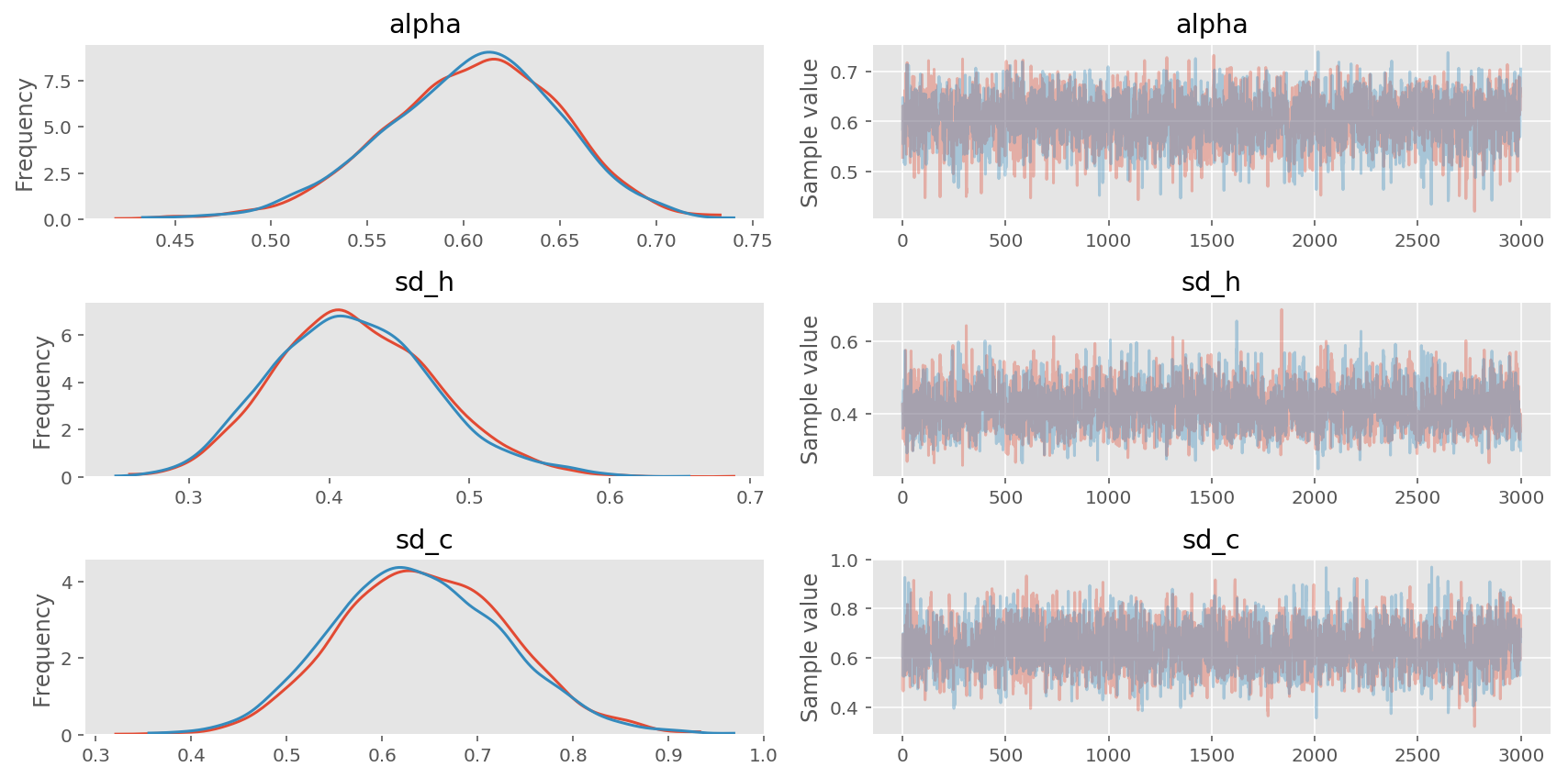
In [8]:
pm.plot_posterior(trace1, varnames=['alpha']);

theano.scan is much faster than using a python for loop, but it is
still quite slow. One of the way to improve is to use linear algebra and
matrix multiplication. In another word, we should try to find a way to
use matrix multiplication instead of for-loop (if you have experience in
using MATLAB, it is the same philosophy). In our case, we can totally do
that.
For a similar problem, you can also have a look of my port of Lee and Wagenmakers’ book. For example, in Chapter 19, the STAN code use a for loop to generate the likelihood function, and I generate the matrix outside and use matrix multiplication etc to archive the same purpose.
PyMC3 implementation using some matrix “trick”¶
Again, we try on some simulation data to make sure the implementation is correct.
In [9]:
maxwz = max([sum(w) for w in weights])
N = len(weights)
wmat2 = np.zeros((N, N))
amat2 = np.zeros((N, N), dtype='int32')
for i, a in enumerate(adj):
amat2[i, a] = 1
wmat2[i, a] = weights[i]
value = np.asarray(np.random.randn(N,), dtype=theano.config.floatX)
print(np.sum(value*amat2, axis=1)/np.sum(wmat2, axis=1))
def mu_phi(value):
N = len(weights)
# Calculate mu based on average of neighbours
mu = np.array([np.sum(weights[i]*value[adj[i]])/Wplus[i] for i in range(N)])
return mu
print(mu_phi(value))
[ 0.31196015 -0.61357254 -0.39801169 -0.29914739 0.10475477 -0.58443596
-0.16833961 -0.14569348 0.217921 -0.65120513 -0.58776908 -0.73258504
-0.12999028 -0.58430732 0.19376804 -0.46436916 0.31726523 0.00458538
-0.36734277 0.46909793 -0.19975836 -0.59468932 -0.0082971 0.56153682
0.33426322 0.15664349 0.12884245 -0.19992449 -0.23370854 -0.08450199
-0.17753823 0.22081404 -0.09694617 0.00834465 -0.67318022 -0.39008615
-0.46966306 0.20615225 0.05952117 0.0694826 -0.37053512 0.11782136
0.29213334 0.10030141 0.12621373 -0.11455156 -0.19670248 0.24437384
0.07395046 0.01040834 0.36075119 0.58773701 0.13158094 0.07227536
0.04784926 0.37265323]
[ 0.31196015 -0.61357254 -0.39801169 -0.29914739 0.10475477 -0.58443596
-0.16833961 -0.14569348 0.217921 -0.65120513 -0.58776908 -0.73258504
-0.12999028 -0.58430732 0.19376804 -0.46436916 0.31726523 0.00458538
-0.36734277 0.46909793 -0.19975836 -0.59468932 -0.0082971 0.56153682
0.33426322 0.15664349 0.12884245 -0.19992449 -0.23370854 -0.08450199
-0.17753823 0.22081404 -0.09694617 0.00834465 -0.67318022 -0.39008615
-0.46966306 0.20615225 0.05952117 0.0694826 -0.37053512 0.11782136
0.29213334 0.10030141 0.12621373 -0.11455156 -0.19670248 0.24437384
0.07395046 0.01040834 0.36075119 0.58773701 0.13158094 0.07227536
0.04784926 0.37265323]
Now create a new CAR distribution with the matrix multiplication instead
of theano.scan to get the mu
In [10]:
class CAR2(distribution.Continuous):
"""
Conditional Autoregressive (CAR) distribution
Parameters
----------
a : adjacency matrix
w : weight matrix
tau : precision at each location
"""
def __init__(self, w, a, tau, *args, **kwargs):
super(CAR2, self).__init__(*args, **kwargs)
self.a = a = tt.as_tensor_variable(a)
self.w = w = tt.as_tensor_variable(w)
self.tau = tau*tt.sum(w, axis=1)
self.mode = 0.
def logp(self, x):
tau = self.tau
w = self.w
a = self.a
mu_w = tt.sum(x*a, axis=1)/tt.sum(w, axis=1)
return tt.sum(continuous.Normal.dist(mu=mu_w, tau=tau).logp(x))
In [11]:
with pm.Model() as model2:
# Vague prior on intercept
beta0 = pm.Normal('beta0', mu=0.0, tau=1.0e-5)
# Vague prior on covariate effect
beta1 = pm.Normal('beta1', mu=0.0, tau=1.0e-5)
# Random effects (hierarchial) prior
tau_h = pm.Gamma('tau_h', alpha=3.2761, beta=1.81)
# Spatial clustering prior
tau_c = pm.Gamma('tau_c', alpha=1.0, beta=1.0)
# Regional random effects
theta = pm.Normal('theta', mu=0.0, tau=tau_h, shape=N)
mu_phi = CAR2('mu_phi', w=wmat2, a=amat2, tau=tau_c, shape=N)
# Zero-centre phi
phi = pm.Deterministic('phi', mu_phi-tt.mean(mu_phi))
# Mean model
mu = pm.Deterministic('mu', tt.exp(logE + beta0 + beta1*aff + theta + phi))
# Likelihood
Yi = pm.Poisson('Yi', mu=mu, observed=O)
# Marginal SD of heterogeniety effects
sd_h = pm.Deterministic('sd_h', tt.std(theta))
# Marginal SD of clustering (spatial) effects
sd_c = pm.Deterministic('sd_c', tt.std(phi))
# Proportion sptial variance
alpha = pm.Deterministic('alpha', sd_c/(sd_h+sd_c))
trace2 = pm.sample(3e3, njobs=2, tune=1000, nuts_kwargs={'max_treedepth': 15})
Auto-assigning NUTS sampler...
Initializing NUTS using ADVI...
Average Loss = 203.33: 8%|▊ | 16201/200000 [00:02<00:29, 6290.09it/s]
Convergence archived at 16500
Interrupted at 16,500 [8%]: Average Loss = 337
100%|██████████| 4000/4000.0 [01:59<00:00, 33.33it/s]
As you can see, its 6x faster using matrix multiplication.
In [12]:
pm.traceplot(trace2, varnames=['alpha', 'sd_h', 'sd_c']);
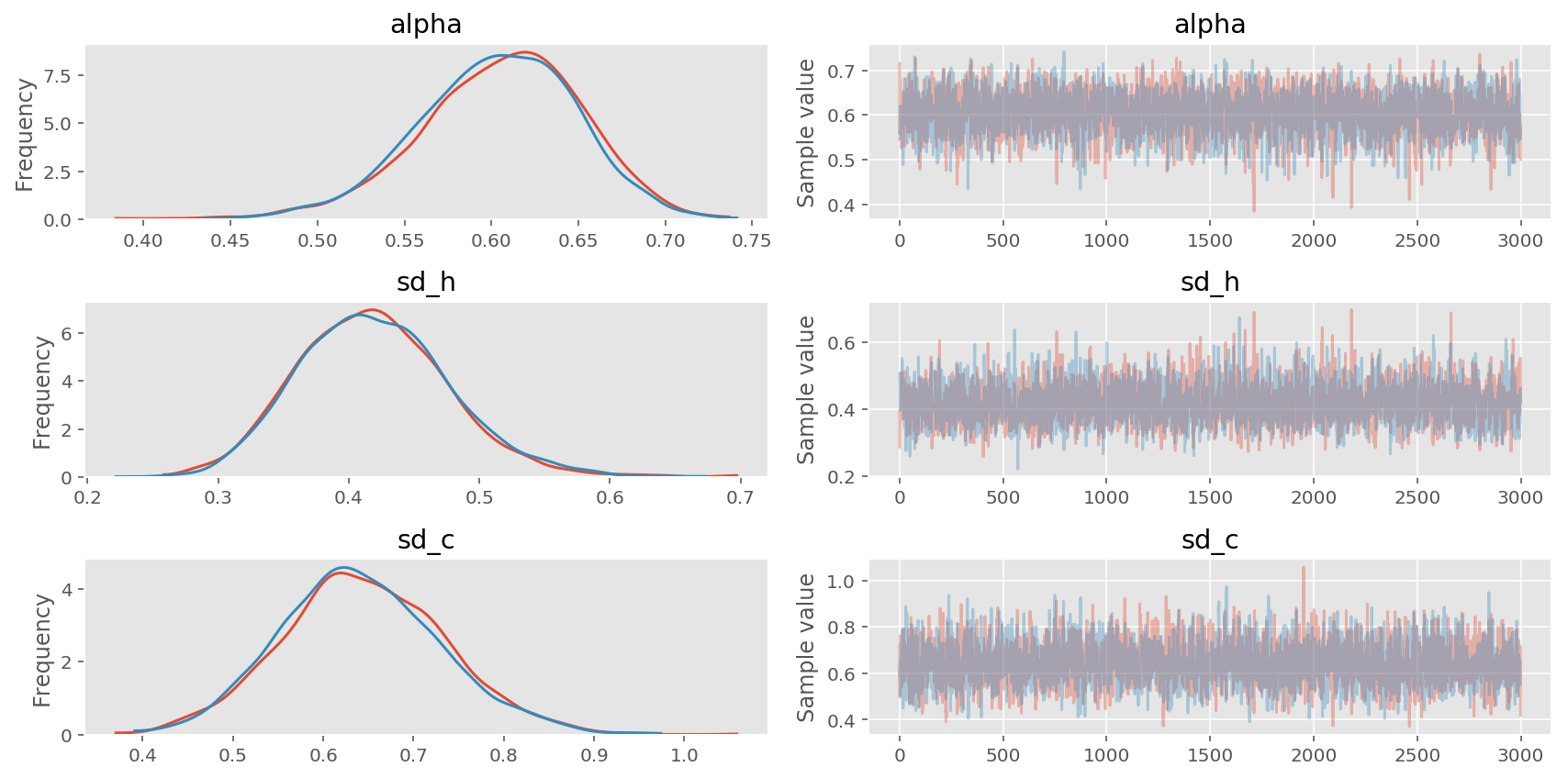
In [13]:
pm.plot_posterior(trace2, varnames=['alpha']);

PyMC3 implementation using Matrix multiplication¶
There are (almost) always many ways to formulate your model. And some works better than the others under different context (size of your dataset, properties of the sampler, etc). In this case, we can expressed the CAR prior as:
For the sake of brevity, you can find more details in the original Stan case study. You might come across similar deviation in Gaussian Process, which result in a zero-mean Gaussian distribution conditioned on a covariance function.
In the Stan Code, matrix D is generated in the model using a
transformed data{} block:
transformed data{
vector[n] zeros;
matrix<lower = 0>[n, n] D;
{
vector[n] W_rowsums;
for (i in 1:n) {
W_rowsums[i] = sum(W[i, ]);
}
D = diag_matrix(W_rowsums);
}
zeros = rep_vector(0, n);
}
We can generate the same matrix quite easily:
In [14]:
X = np.hstack((np.ones((N, 1)), stats.zscore(aff, ddof=1)[:, None]))
W = wmat2
D = np.diag(W.sum(axis=1))
log_offset = logE[:, None]
Then in the STAN model:
model {
phi ~ multi_normal_prec(zeros, tau * (D - alpha * W));
...
}
since the precision matrix just generated by some matrix multiplication,
we can do just that in PyMC3:
In [17]:
with pm.Model() as model3:
# Vague prior on intercept and effect
beta = pm.Normal('beta', mu=0.0, tau=1.0, shape=(2, 1))
# Priors for spatial random effects
tau = pm.Gamma('tau', alpha=2., beta=2.)
alpha = pm.Uniform('alpha', lower=0, upper=1)
phi = pm.MvNormal('phi', mu=0, tau=tau*(D - alpha*W), shape=(1, N))
# Mean model
mu = pm.Deterministic('mu', tt.exp(tt.dot(X, beta) + phi.T + log_offset))
# Likelihood
Yi = pm.Poisson('Yi', mu=mu.ravel(), observed=O)
trace3 = pm.sample(3e3, njobs=2, tune=1000)
Auto-assigning NUTS sampler...
Initializing NUTS using ADVI...
Average Loss = 174.93: 8%|▊ | 16680/200000 [00:23<03:33, 858.62it/s]
Convergence archived at 16700
Interrupted at 16,700 [8%]: Average Loss = 265.66
100%|██████████| 4000/4000.0 [03:00<00:00, 22.15it/s]
In [18]:
pm.traceplot(trace3, varnames=['alpha', 'beta', 'tau']);
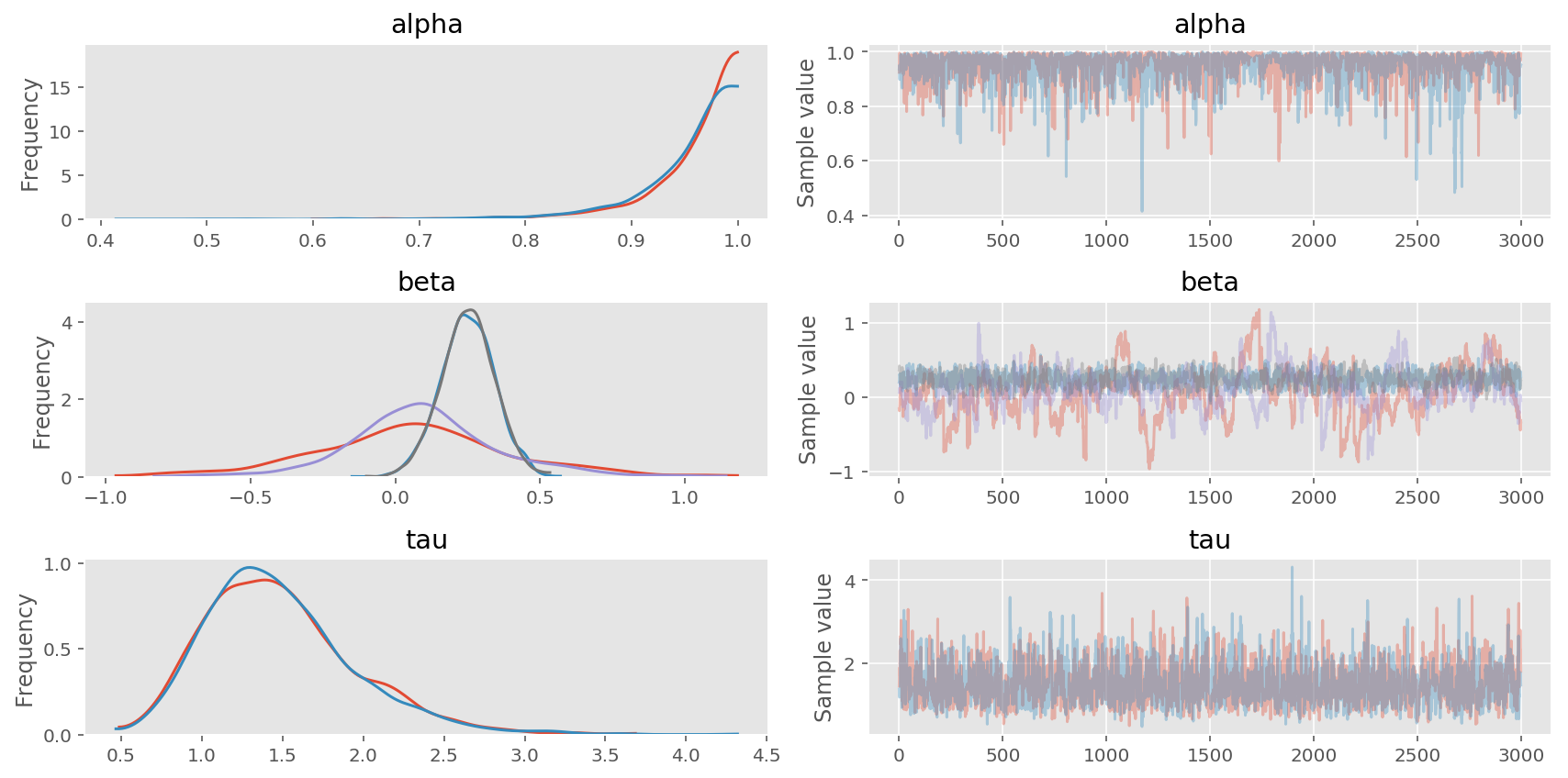
In [19]:
pm.plot_posterior(trace3, varnames=['alpha']);

Notice that since the model parameterization is different than in the
WinBugs model, the alpha doesn’t bear the same interpretation.
PyMC3 implementation using Sparse Matrix¶
Note that in the node \(\phi \sim \mathcal{N}(0, [D_\tau (I - \alpha B)]^{-1})\), we are computing the log-likelihood for a multivariate Gaussian distribution, which might not scale well in high-dimension. We can take advantage of the fact that the covariance matrix here \([D_\tau (I - \alpha B)]^{-1}\) is sparse, and there are faster ways to compute log-likelihood.
For example, a more efficient sparse representation of the CAR in
STAN:
functions {
/**
* Return the log probability of a proper conditional autoregressive (CAR) prior
* with a sparse representation for the adjacency matrix
*
* @param phi Vector containing the parameters with a CAR prior
* @param tau Precision parameter for the CAR prior (real)
* @param alpha Dependence (usually spatial) parameter for the CAR prior (real)
* @param W_sparse Sparse representation of adjacency matrix (int array)
* @param n Length of phi (int)
* @param W_n Number of adjacent pairs (int)
* @param D_sparse Number of neighbors for each location (vector)
* @param lambda Eigenvalues of D^{-1/2}*W*D^{-1/2} (vector)
*
* @return Log probability density of CAR prior up to additive constant
*/
real sparse_car_lpdf(vector phi, real tau, real alpha,
int[,] W_sparse, vector D_sparse, vector lambda, int n, int W_n) {
row_vector[n] phit_D; // phi' * D
row_vector[n] phit_W; // phi' * W
vector[n] ldet_terms;
phit_D = (phi .* D_sparse)';
phit_W = rep_row_vector(0, n);
for (i in 1:W_n) {
phit_W[W_sparse[i, 1]] = phit_W[W_sparse[i, 1]] + phi[W_sparse[i, 2]];
phit_W[W_sparse[i, 2]] = phit_W[W_sparse[i, 2]] + phi[W_sparse[i, 1]];
}
for (i in 1:n) ldet_terms[i] = log1m(alpha * lambda[i]);
return 0.5 * (n * log(tau)
+ sum(ldet_terms)
- tau * (phit_D * phi - alpha * (phit_W * phi)));
}
}
with the data transformed in the model:
transformed data {
int W_sparse[W_n, 2]; // adjacency pairs
vector[n] D_sparse; // diagonal of D (number of neigbors for each site)
vector[n] lambda; // eigenvalues of invsqrtD * W * invsqrtD
{ // generate sparse representation for W
int counter;
counter = 1;
// loop over upper triangular part of W to identify neighbor pairs
for (i in 1:(n - 1)) {
for (j in (i + 1):n) {
if (W[i, j] == 1) {
W_sparse[counter, 1] = i;
W_sparse[counter, 2] = j;
counter = counter + 1;
}
}
}
}
for (i in 1:n) D_sparse[i] = sum(W[i]);
{
vector[n] invsqrtD;
for (i in 1:n) {
invsqrtD[i] = 1 / sqrt(D_sparse[i]);
}
lambda = eigenvalues_sym(quad_form(W, diag_matrix(invsqrtD)));
}
}
and the likelihood:
model {
phi ~ sparse_car(tau, alpha, W_sparse, D_sparse, lambda, n, W_n);
}
There are quite a lot of codes to digest, my general approach is to
compare the intermedia step whenever possible with STAN. In this
case, I will try to compute
tau, alpha, W_sparse, D_sparse, lambda, n, W_n outside of the
STAN model in R and compare with my own implementation.
Below is a Sparse CAR implementation in PyMC3 (see also
here).
Again, we try to avoide using any for-loop as in STAN.
In [20]:
import scipy
class Sparse_CAR(distribution.Continuous):
"""
Sparse Conditional Autoregressive (CAR) distribution
Parameters
----------
alpha : spatial smoothing term
W : adjacency matrix
tau : precision at each location
"""
def __init__(self, alpha, W, tau, *args, **kwargs):
self.alpha = alpha = tt.as_tensor_variable(alpha)
self.tau = tau = tt.as_tensor_variable(tau)
D = W.sum(axis=0)
n, m = W.shape
self.n = n
self.median = self.mode = self.mean = 0
super(Sparse_CAR, self).__init__(*args, **kwargs)
# eigenvalues of D^−1/2 * W * D^−1/2
Dinv_sqrt = np.diag(1 / np.sqrt(D))
DWD = np.matmul(np.matmul(Dinv_sqrt, W), Dinv_sqrt)
self.lam = scipy.linalg.eigvalsh(DWD)
# sparse representation of W
w_sparse = scipy.sparse.csr_matrix(W)
self.W = theano.sparse.as_sparse_variable(w_sparse)
self.D = tt.as_tensor_variable(D)
# Presicion Matrix (inverse of Covariance matrix)
# d_sparse = scipy.sparse.csr_matrix(np.diag(D))
# self.D = theano.sparse.as_sparse_variable(d_sparse)
# self.Phi = self.tau * (self.D - self.alpha*self.W)
def logp(self, x):
logtau = self.n * tt.log(tau)
logdet = tt.log(1 - self.alpha * self.lam).sum()
# tau * ((phi .* D_sparse)' * phi - alpha * (phit_W * phi))
Wx = theano.sparse.dot(self.W, x)
tau_dot_x = self.D * x.T - self.alpha * Wx.ravel()
logquad = self.tau * tt.dot(x.ravel(), tau_dot_x.ravel())
# logquad = tt.dot(x.T, theano.sparse.dot(self.Phi, x)).sum()
return 0.5*(logtau + logdet - logquad)
In [21]:
with pm.Model() as model4:
# Vague prior on intercept and effect
beta = pm.Normal('beta', mu=0.0, tau=1.0, shape=(2, 1))
# Priors for spatial random effects
tau = pm.Gamma('tau', alpha=2., beta=2.)
alpha = pm.Uniform('alpha', lower=0, upper=1)
phi = Sparse_CAR('phi', alpha, W, tau, shape=(N, 1))
# Mean model
mu = pm.Deterministic('mu', tt.exp(tt.dot(X, beta) + phi + log_offset))
# Likelihood
Yi = pm.Poisson('Yi', mu=mu.ravel(), observed=O)
trace4 = pm.sample(3e3, njobs=2, tune=1000)
Auto-assigning NUTS sampler...
Initializing NUTS using ADVI...
Average Loss = 164.83: 8%|▊ | 16253/200000 [00:02<00:33, 5513.12it/s]
Convergence archived at 16700
Interrupted at 16,700 [8%]: Average Loss = 255.36
100%|██████████| 4000/4000.0 [00:13<00:00, 298.68it/s]
In [22]:
pm.traceplot(trace4, varnames=['alpha', 'beta', 'tau']);
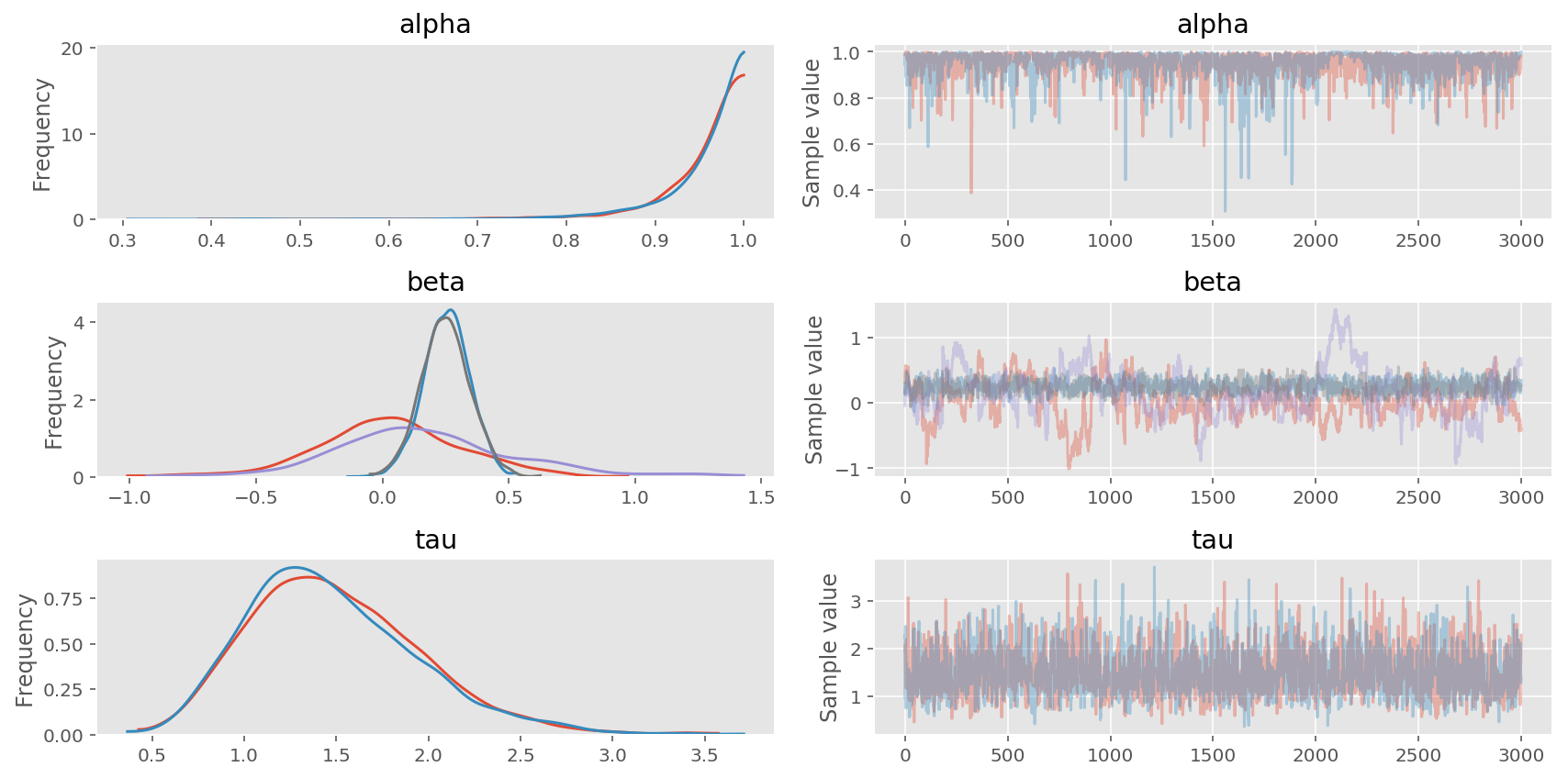
In [23]:
pm.plot_posterior(trace4, varnames=['alpha']);

As you can see above, the sparse representation returns the same estimation, while being much faster than any other implementation.
A few other warnings¶
In Stan, there is an option to write a generated quantities
block for sample generation. Doing the similar in pymc3, however, is not
recommended.
Consider the following simple sample:
# Data
x = np.array([1.1, 1.9, 2.3, 1.8])
n = len(x)
with pm.Model() as model1:
# prior
mu = pm.Normal('mu', mu=0, tau=.001)
sigma = pm.Uniform('sigma', lower=0, upper=10)
# observed
xi = pm.Normal('xi', mu=mu, tau=1/(sigma**2), observed=x)
# generation
p = pm.Deterministic('p', pm.math.sigmoid(mu))
count = pm.Binomial('count', n=10, p=p, shape=10)
where we intended to use
python count = pm.Binomial('count', n=10, p=p, shape=10) to generate
posterior prediction. However, if the new RV added to the model is a
discrete variable it can cause weird turbulence to the trace. You can
see issue #1990 for
related discussion.
Final remarks¶
In this notebook, most of the parameter conventions (e.g., using tau
when defining a Normal distribution) and choice of priors are strictly
matched with the original code in Winbugs or Stan. However, it
is important to note that merely porting the code from one to the other
is not always the best practice. The aims are not just to run the code
in PyMC3, but to make sure the model is appropriate as it returns
correct estimation, and runs efficiently (fast sampling).
For example, as [@aseyboldt](https://github.com/aseyboldt) pointed out
here
and
here,
non-centered parametrizations are often a better choice than the
centered parametrizations. In our case here, phi is following a
zero-mean Normal distribution, thus it can be leaved out in the
beginning and just scale the values afterwards. In many cases doing this
can avoids correlations in the posterior (it will be slower in some
cases, however).
Another thing to keep in mind is that sometimes your model is sensitive to prior choice: for example, you can have a bad experiences using Normals with a large sd as prior. Gelman often recommends Cauchy or StudentT, and more heuristic on prior could be found on the Stan wiki.
There are always ways to improve (tidy up the code, more careful on the
matrix multiplication, etc,.). Since our computational graph under
pm.Model() are all theano objects, we can always do
print(VAR_TO_CHECK.tag.test_value) right after the declaration or
computation to check the shape. For example, in our last example, as
suggested by
[@aseyboldt](https://github.com/pymc-devs/pymc3/pull/2080#issuecomment-297456574)
there seem to be a lot of correlations in the posterior. That probably
slows down NUTS quite a bit. As a debugging tool and guide for
reparametrization you can look at the singular value decomposition of
the standardized samples from the trace – basically the eigenvalues of
the correlation matrix. If the problem is high dimensional you can use
stuff from scipy.sparse.linalg to only compute the largest singular
value:
from scipy import linalg, sparse
vals = np.array([model.dict_to_array(v) for v in trace[1000:]]).T
vals[:] -= vals.mean(axis=1)[:, None]
vals[:] /= vals.std(axis=1)[:, None]
U, S, Vh = sparse.linalg.svds(vals, k=20)
Then look at plt.plot(S) to see if any principal components stick
out, and check which variables are involved by looking at the singular
vectors: plt.plot(U[:, -1] ** 2). You can get the indices by looking
at model.bijection.ordering.vmap.
Another great way to check the correlations in the posterior is to do a pairplot of the posterior (if your model doesn’t contain too many parameters). You can see quite clearly if and where the the posterior parameters are correlated.
In [24]:
import seaborn as sns
tracedf1 = pm.trace_to_dataframe(trace1, varnames=['beta0', 'beta1', 'tau_h', 'tau_c'])
sns.pairplot(tracedf1);
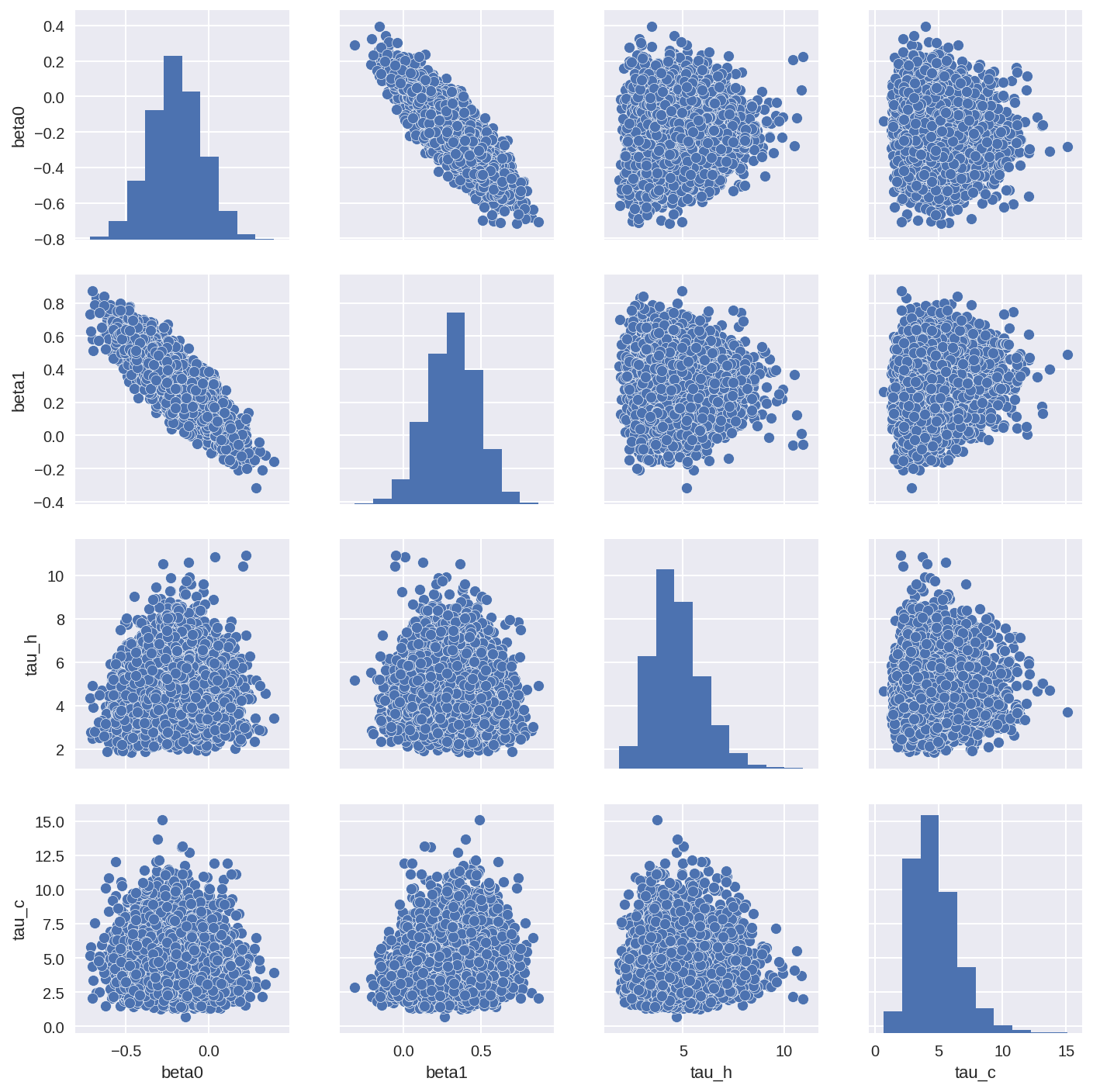
In [25]:
tracedf2 = pm.trace_to_dataframe(trace2, varnames=['beta0', 'beta1', 'tau_h', 'tau_c'])
sns.pairplot(tracedf2);
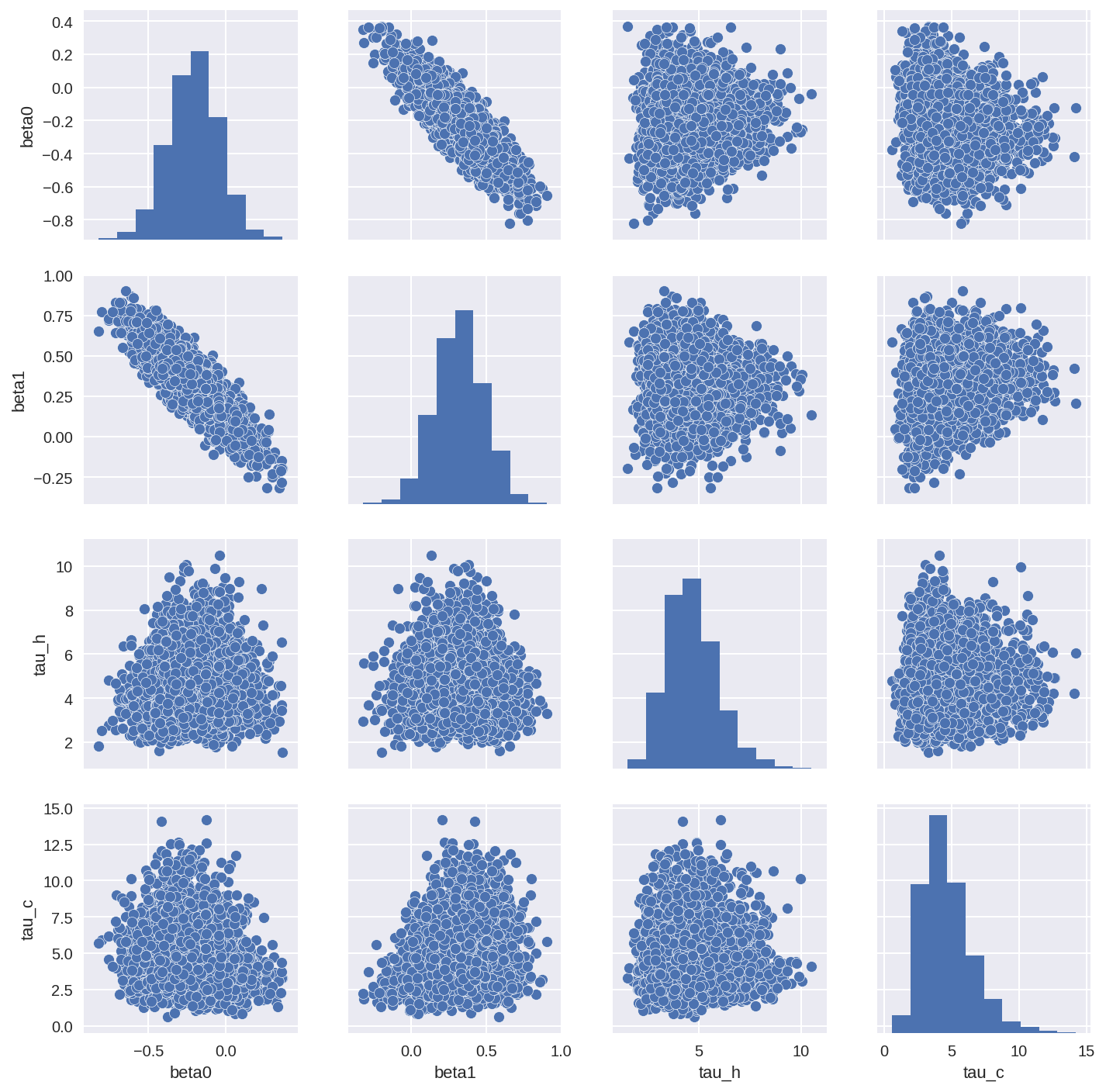
In [26]:
tracedf3 = pm.trace_to_dataframe(trace3, varnames=['beta', 'tau', 'alpha'])
sns.pairplot(tracedf3);
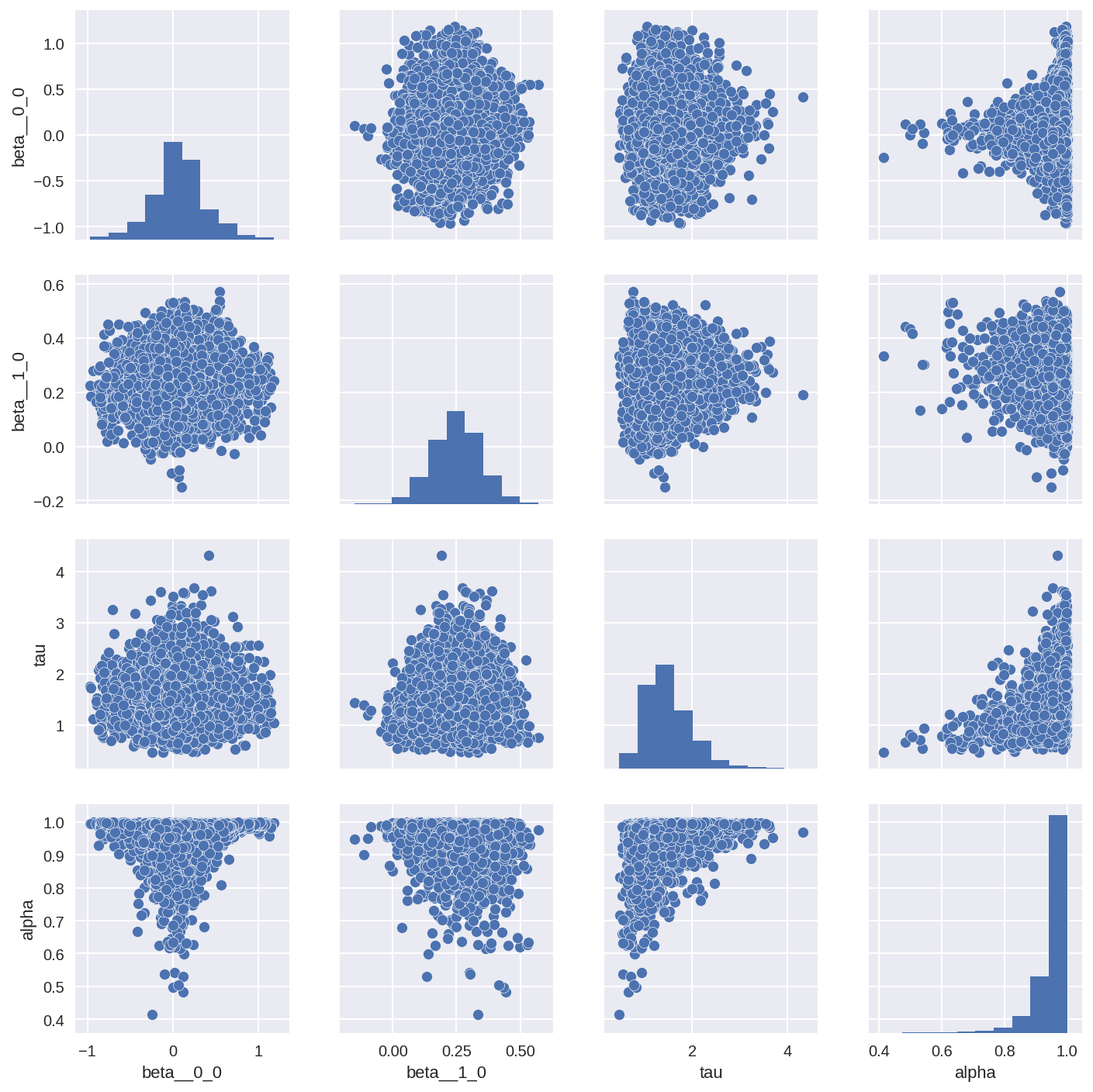
In [27]:
tracedf4 = pm.trace_to_dataframe(trace4, varnames=['beta', 'tau', 'alpha'])
sns.pairplot(tracedf4);
